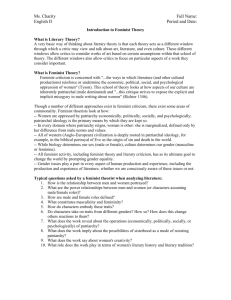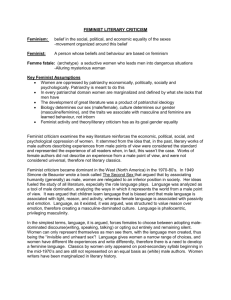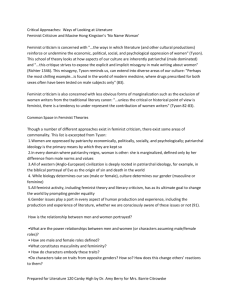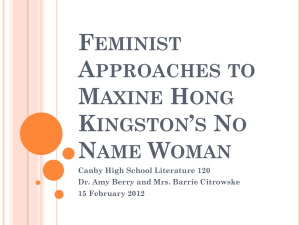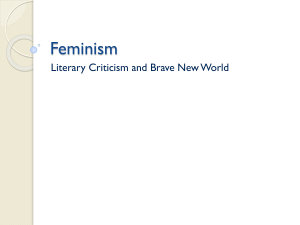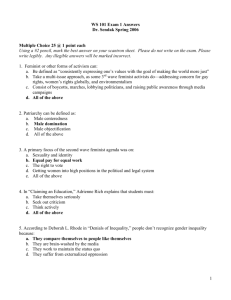Rethinking `Patriarchy` in a Rural Context
advertisement
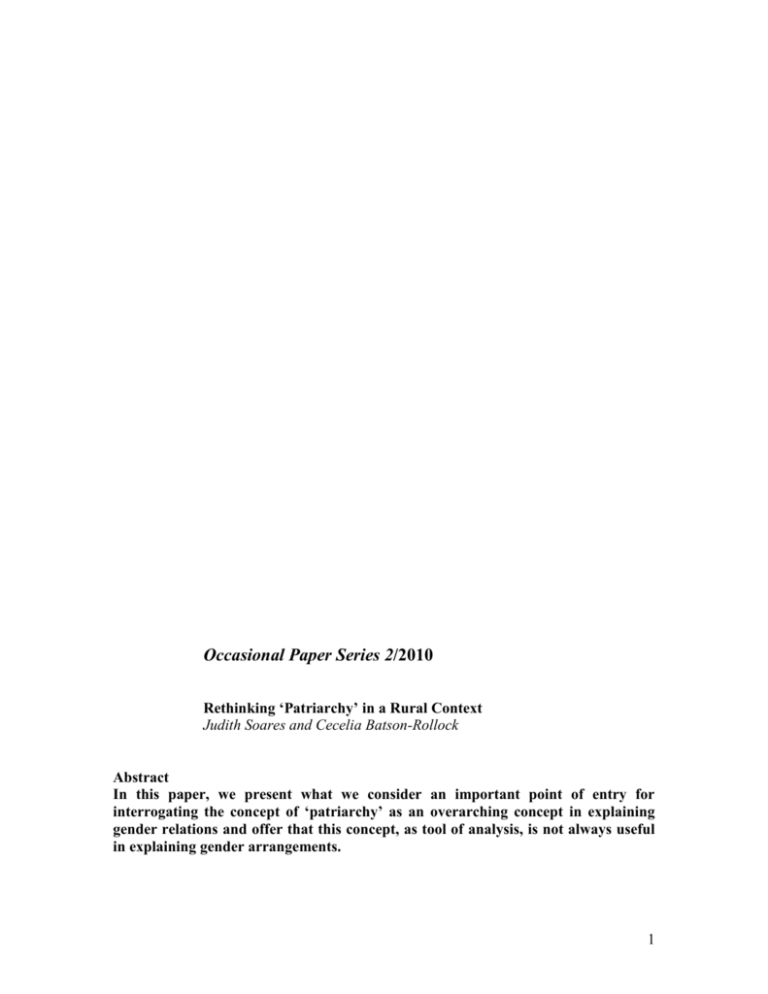
Occasional Paper Series 2/2010 Rethinking ‘Patriarchy’ in a Rural Context Judith Soares and Cecelia Batson-Rollock Abstract In this paper, we present what we consider an important point of entry for interrogating the concept of ‘patriarchy’ as an overarching concept in explaining gender relations and offer that this concept, as tool of analysis, is not always useful in explaining gender arrangements. 1 Noting the way in which historical transformations can affect the relations between women and men as individuals and as social groups, we argue that the material conditions of a society based on equal access to resources and the main means of production determine social interaction, and can influence the expression of gender roles and situations of relative gender equality. To illustrate our point we refer to the experience of a rural farming community in St. Vincent and the Grenadines where women and men see themselves as social equals. Introduction: The Concept of ‘Patriarchy’ More than any other school of feminist thought, that of radical feminism has made the most significant contribution to the development of feminism as a body of knowledge. In their seminal contribution to feminist theorising, radical feminists isolated the concept and theory of ‘patriarchy’ as the main factor responsible for women’s subordination and male arrogance in both the private and public spheres. Contending that ‘patriarchy’ is a system of power relations which underlies the organisation of society into its complex matrix of unequal relations between an oppressive male presence and an oppressed female population, radical feminism challenges ‘patriarchy’ by opposing constructed gender roles, brought on by men’s oppression of women. Instead, this body of thought calls for a radical reordering of social relations and of society itself. Essentially, radical feminism argues that ‘patriarchy’ is the defining feature of contemporary society and, hence, the root of women’s oppression is to be found in patriarchal gender relations which if not overthrown will perpetuate the exploitation of women for the benefit of men. As Rosemarie Tong puts it, for “radical feminists…it is the patriarchal system that oppresses women, a system characterized by power, dominance, hierarchy, and competition, a system that cannot be reformed but only ripped out root and branch” (1989: 2-3). At the same time ideas of ‘patriarchy’, like all other ideas of domination, have been disseminated through negative cultural traditions and civil society’s material and institutional structures. These include the family, schools, the media and religious institutions. As Acosta-Belen and Bose state, “the subordination of women has been ideologically conceived as an integral part of the natural order of things and perpetuated by praxis, religion, education and other social institutions”(Acosta-Belen and Bose:1995: 15). It is because of this that Tong further states that “it is not just patriarchy’s legal and political system that must be overturned; its social and cultural institutions (especially the family, the church and the academy) must also go” (1989: 3). By ascribing women’s oppression to male supremacy and by arguing for the elimination of male dominance and supremacy and for the liberation of women, radical feminism has laid the foundation on which feminist theorising, in its various forms, has been constructed as ideology and theory. In fact, it could be said that radical feminism is responsible for the expression of many of the ideas of feminism, shaped and developed into their various strands. According to Humm (1995) “each feminist theory finds that a different feature of patriarchy defines women’s subordination” (p. 200) as expressed in the works of radical socialist, Marxist and psychoanalyst feminists such as Firestone (1970); Millet (1970); Barrett (1980); Hartmann (1976); Mitchell (1974); Dinnerstein (1976) Rubin (1984); and Daley (1968, 1973). These feminists, for example, bring to the 2 conceptualisation of ‘patriarchy’ different features, but with a core concept relating to the subordination of women through patriarchal ideology and practice. In the tradition of radical feminism, then, contemporary feminists, from their different strands of thought, argue generally that ‘patriarchy’ “has power from men’s greater access to, and mediation of, the resources and rewards of authority structures inside and outside the home” (Humm: 1995: 200). Essentially, the concept of patriarchy is critical to contemporary feminism, as Humm points out, as a body of thought which seeks to explain women’s subordination and the “totality of oppressive and exploitative relations which affect women” (Humm: 1995: 200). While it may seem that the concept of ‘patriarchy’ can be universalised in its application, there are some feminists like Rowbothom (1983) who caution against its universal usage because such usage, they argue, should be contexualised within the socio-history of the particular society which is under scrutiny in order to give specific meaning to any gender analysis. Failure to do so would result in an ahistorical and mechanistic analysis which would mask the real meaning of social phenomena and/or issues of social relations between women and men. While Rowbothom is taken with the ahistorical character of the concept, Deniz Kandiyota (1997) is quick to point out that this concept is not always useful as tool of analysis. In this, she agrees with Rowbothom’s conceptual viewpoint but from a different angle. Kandiyota claims that the usage of ‘patriarchy’ is too generalised for it to have meaning. In this respect, it does not provide a sound ideological, cultural or historical framework within which to analyse “distinct arrangements between genders”. Of all the concepts generated by contemporary feminist theory, patriarchy is probably the most overused and, in some respects, the most undertheorized. This state of affairs is not due to neglect, since there is a substantial volume of writing on the question, but rather to the specific conditions of development of contemporary feminist usages of the term. While radical feminists encouraged a very liberal usage, to apply to virtually any form or instance of male domination, socialist feminists have mainly restricted themselves to analysing the relationships between patriarchy and class under capitalism. As a result, the term patriarchy evokes an overly monolithic conception of male dominance, which is treated at a level of abstraction that obfuscates rather than reveals the intimate inner workings of culturally and historically distinct arrangements between the genders (p. 86). She, therefore, offers “an important and relatively neglected point of entry for the identification of different forms of patriarchy through an analysis of women’s strategies in dealing with them” (Kandiyota: 1997, p.86). In this respect, she advises that “women strategise within a set of concrete constraints that reveal and define the blueprint” of which she terms the “patriarchal bargain” of any society which is based on distinctions of class, caste and ethnicity. Such patriarchal bargains, she continues, “exert a powerful influence on the shaping of women’s gendered subjectivity and determine the nature of gender ideology in different contexts” (Kandiyota: 1997 p. 86). They also influence the nature and form of women’s resistance to various forms of oppression while being susceptible to historical transformations which can lead to new areas of struggle and ‘renegotiation of relations between genders” (Kandiyota: 1997, p. 87). While we accept that ‘patriarchy’ is fundamental to contemporary feminist thought, whatever its strandi, and recognise its liberal usage and complexity in definition, our research has revealed that ‘patriarchy’, as a pure concept, is not always useful as a conceptual tool of analysis in understanding or explaining gender arrangements. Our 3 view is more in line with Kandiyota’s that there is the “existence of set rules and scripts regulating gender relations, to which both genders accommodate and acquiesce, yet which may nonetheless be contested, redefined and renegotiated” (p. 97). In this regard, we also agree that gender relations can, indeed, be transformed, redefined and renegotiated. Our point of departure, however, is that we argue that such gender relations, while subject to redefinition, renegotiation and transformation, are not necessarily subject to contestation under particular socio-historical conditions and in specific cultural contexts. It is also our view that the “existence of set rules and scripts regulating gender relations’, assumed to be socially constructed by a ‘patriarchal’ society, can also be reversed or negated in favour of more palatable ‘rules and scripts’ which govern the relations between women and men. This, however, is, dependent on the existence of particular historical and social circumstances. Our argument finds support in the findings of our recent interrogation of social life in a small rural and remote community in St. Vincent and the Grenadines, Fancy. The findings indicate that the concept, ideology and practice of ‘patriarchy’ do not dominate social relations between women and men. In this community, where there are no male hierarchical relations and where there are expressions of men’s solidarity with women, and women’s solidarity with men, men agree that women are, in fact, their equals and that “women and men have the same rights” (Paul interview: 2008)ii. Within the body of feminist thought, this appears as an anomaly and out of keeping with any feminist theorising on the unequal relations of power which are said to characterise gender arrangements. The expression, then, of “men and women having equal rights” and ‘men’s equality with women’ points to the need to reconceptualise or to rethink ‘patriarchy’ and to draw within its ambit, the more subtle distinctions which can give more meaning to general theories as the combination of the specific and the general provides a more meaningful picture of social phenomena. This is important because the case of Fancy provides an interesting theoretical and practical situation, precisely because within the wider Vincentian community, the ideas and practice of patriarchy have resulted in the exclusion and marginalisation of women in a system which operates on male dominance, male hierarchical relations and male solidarity (Soares: 2007). These ideas have not penetrated the community which has preserved relatively equal social relations. Our intention, then, was to unravel the underlying reasons for the lack of ideological penetration and the absence of constructed gender roles. In attempting to explain the unique social relations being experienced in the farming community of Fancy, we argue, based on our investigation, that gender relations were not just transformed, but were redefined and not contested within a particular socio-cultural and historical context and on a particular material base. This material base is a land tenure system which has passed from generation to generation (Joy, 2007, Ashton 2002). In addition, the pattern of landownership, as we offer, eroded the ideology and practice of ‘patriarchy’ by erasing lines of social demarcation which has encouraged the absence of a gendered division of labour which, according to feminist theory, is occasioned by the unequal structuring of women’s and men’s work. (Kuhn and Wolpe, 1978; Firestone, 1968, 1970; Hart, 1992). It was, therefore, not difficult for the women and men of Fancy to embrace the practice of ‘equal relations between women and men’, for, with this 4 pattern of landownership, we further argue, came the transformation of ideas of male dominance and women’s subordination held in the collective consciousness of a people who feel that women, like men, should control their own destiny (Soares, 2007). (Here we speak not of ‘gender equality’ but of social justice). Our methods of investigation which took place over a period of two years (2006-2008) included informal interviews with women and men, observer participation and group meetings of women. The Status of Women in St. Vincent and the Grenadines Numerically, women outnumber men in most countries of the Anglophone Caribbean where, generally speaking, for every 100 men there are 103 women (CARICOM: various years). However, in St. Vincent and the Grenadines, a small country with a population of some 119,000, women exceeded men in 2000 but by 2005, women represented some 50.4 per cent of the total population. Despite this, Vincentian women and men have, historically, coexisted in a society where gender disparities and unacceptable unequal relations of power persist. Women and men in St. Vincent and the Grenadines, therefore, do not enjoy equal social, economic and political relationships. For, while women and men must work and live together, there are differentials in their condition of life in a region and country where there is a differential articulation of the impact of policy and policymaking along the lines of race, class, and gender. This means that women continue to face discrimination as a matter of course (Soares, 2007). The country’s report to the Third World Conference on Women held in Nairobi, Kenya in 1985 noted as follows. [W]omen were mostly employed in low paying, low status, low skilled areas, which brought low economic returns. Unemployment was higher among them than their male counterparts and they tended to have fewer technical skills than men. In addition to limited employment opportunities, inflexible working hours, lack of support structures for women who wanted to combine family and employment responsibilities…those who worked in the industrial and agricultural sectors were discriminated against since they did not receive the same pay as men for the work which they performed (cited in Ollivierre: 2000: 1). For the majority of women, there was no significant shift in their conditions of life. Of the approximately 37 percent of Vincentians who fall below the poverty line, “a great number…are women” who live in deplorable conditions of poverty despite the government’s ‘war on poverty’ (Status of Women Report: 2003). Poverty reduction measures which were not gender specific did not address the crux of the social and economic situation. It was concluded, then, in the government’s “Interim Poverty Reduction Strategy Paper” that “marked gender disparities exist reflecting the different roles, responsibilities and options available to men and women which will unless addressed comprehensively, continue to be a significant restraint on progress in St. Vincent and the Grenadines” (Status of Women Report: 2003). Women did not figure centrally in the socio-politics and economics of this small import-oriented, exportpropelled economy where women’s issues were recognised as deserving of attention, but not of action. Among these women were the women of Fancy whose social experience 5 excluded notions and practice of gender disparities, male dominance and social exclusion. Fancy: The Community Fancy is a small remote rural community located at the northernmost point of St. Vincent and the Grenadines. It is a community of small farmers and to a lesser extent fisherfolk. The community comprises one primary school, a health clinic with regular opening hours, and several churches and the main means of subsistence are is cash crop farming. While there is a post office, there are no government offices, commercial banks, nonbank financial institutions or other business enterprises to facilitate monetary transactions or to provide employment. Women, which number 269 of a population of 500, are either farmers or homemakers or both. Although the community is a remote one, community members are linked to the ‘outside world’ through telephone connection (both landline and cellular telephones) and a cooperatively-owned transport bus which makes daily runs to Kingstown, the country’s capital which is about 36 miles to the south. In terms of access, there is only one entrance and exit to the community which lies in a hilly terrain in an area which is prone to land and rock slides. Fancy is an interesting community in terms of its social dynamics. It is a socially cohesive community built on the spirit of kinship, the extended family and collective/communal action. In this community where women reported that their relationship with their husbands and partners is “good”, social discord is virtually absent and the physical abuse of women by their men is not a part of the community’s culture. However, verbal abuse takes place at times, particularly when the husband or partner is drunk. When this happens the community intervenes to diffuse the conflict in order to prevent an escalation of the situation. In the same way if there is a dispute between or among community members, “it is solved by the community to prevent fights… the community leads by example” (Joy/Melba interviews, 2007). While alcohol may be abused by men, there is no evidence of the abuse of any other substance. Substance abuse among women is virtually absent. What is also worthy of note is that the community is crime free. Its crime-free status is easily recognisable because there is no police station and there is no patrolling police presence in the community. In terms of their relationship with their husbands and partners, the women inform that “it is good”, and “jealously and suspicion do not exist in the community…our men go out by themselves and we go out by ourselves” (Joy/Melba interviews, 2007). Husbands and partners show an interest in their women’s community development activities and do not question their absence from the home. It is a community in which both women and men work together for their own good and for the good of the community as a whole. ‘Patriarchy’ is Transformed Fancy, with a history of slavery and colonialism, was once an agricultural plantation, producing crops for export and for local consumption. With the end of plantation agriculture, the land was bequeathed by the then estate owner to the former workers and residents of the community to be owned as common property: to be owned by all and to 6 be dominated or ruled by none (Ashton, FCHG, Informal Discussion: 2008). In fact, the people own the community and the community owns the people. This pattern of communal land ownership is much akin to the natural economy of the early native peoples, the first residents of St. Vincent and the Grenadines. In this communal existence, there is no vertical stratification of the community, and the division of labour is close to being socially symmetrical. Both women and men are engaged in small crop farming (and fishing to a lesser extent) as partners and as individual owners of land which gives them free, unencumbered access to the main means of production. Arable farm land, therefore, became available to all those (women, men, families) who wished to be involved in farming as a means of subsistence. Anyone, woman, man or family can farm any piece of land as long as it is not being farmed by anyone else. The rules of engagement for the “management” and “distribution” of this social property, as a collective enterprise and as a cooperative community of citizens, were inherent in the nature of the transfer of such property. Consequently, the people of Fancy managed, in common, agricultural production based on socialised means of production and collective labour, which coincides with the cultural concept and practice of what is known as ‘swap labour’, that is, voluntary collective labour to work farms, build houses, carry out general communitybuilding activities and work in related processes. At the same time, land on which to build houses became available to all women, men and families on an equal basis. Therefore, in a community with a population of just over 500 and with 140 households, all own farm land and some “99 percent of us own our houses because of the nature of how the land was acquired…some people live at home…there are no rentals and you can live in somebody’s house if they are not around” (Informal interview, FCHG member: 2007). Resulting from this pattern of communal landownership is the way in which work is organised within the community. Within the wider society, work is organised along the lines of a gendered division of labour in an exploitative relationship, which, according to Marxist feminists, is the basis of the unequal relations of the two sexes. In this construction, women’s work is structured in the sense that women are limited to jobs which reflect the feminine which pits them in diametrical opposition to men and men’s work “since the attribution of skill is a patriarchal not an empirical matter (Humm, 1995, 68). Firestone, for example, argues that the division of labour is fundamental to the ‘differences in power’ between women and men in a situation where tasks and roles assigned to men are given greater significance, importance and value than those assigned to women. This is not the case in Fancy where women both work their own plots of land or work alongside their men as partners, and even participate in ‘swap labour’. However, the dominant system of social and economic existence is one of cooperation and partnership. Therefore, the issue of a gendered division of labour does not arise. Nor do the issues of socially constructed gender roles and gender rules. The women of Fancy agree that there are no set gender roles or gender rules for women and men in the community because equal access to land, the main means of survival, gives them equal status with their men. Because of this social relationship men are not in a position to exercise power over their women and they do not. Like the women, they claim that equal access to the resources in the community means equal status and equal rights. They also support the view carried by national and international feminists and included in the Platform for Action and the Beijing Declaration (1995) that women have “the right to 7 own property and things for themselves”, should “share” and “should have equal rights” Informal Interview, Paul, husband of FCHG member 2007). It is the equal access to the means of production which has eroded any ideas of men’s dominance over women and creates the basis for equality in the ‘division’ of tasks and the division of labour. As another husband stated, “women and men tend their farms together, build their houses together and do house work together wife and husband will work together in building farms, and in the home…men will cook” (Informal interview, 2008). Therefore, in both a theoretical and practical sense, the men in Fancy cannot and have not claimed ‘power’ from their “greater access to, and mediation of, the resources and rewards of authority structures inside and outside the home”. Nor can it be said that a sex-gender system and system of socio-economic discrimination and social and economic exploitation of women operates in the Fancy community. Land ownership and notions of equality, therefore, have passed down through generations. In the absence of a gendered or sexual division of labour, work is cooperative, communal and in the interest of the common good. This is expressed in other areas of life as witnessed, for example, in the fact that the only form of transport to and from the community, a bus, is owned by members of the community as a cooperative venture. In the specific case of gender relations, we argue, then, that it is this socio-historical relationship to the main means of production that has caused ideas of patriarchy to crumble, thus altering what was once a patriarchal script, in the plantation era. It is this altered script which has led to the erosion of notions of power and inequality and underlies the sense of equality held by both women and men. According to Joy, who indicated that she was born and raised into a situation where men were not opposed to women’s rights and where men and women were on an equal footing, “we have equal access to the resources…it is part of our history and culture that men were always favourable to women, I born come see this…[our men] fully support [us] and they show an interest in our work…our relationship with our husbands is good” (Interview 2007). For Melba, “this is the community culture, it is the community norm”. Hence, with a pure population of Black African descendants and with a collective approach to community life, Fancy’s social structure is not defined by contradictions or conflicts of gender, class, race or colour. Perhaps, this might also explain the absence of crime and criminal activity and social conflicts in the community (Informal Discussion with FCHG members, 2007)) which are to be found in a number of other communities in St. Vincent and the Grenadines, the Caribbean and, in fact, the world. Women are not being physically abused by their husbands, this is almost absent in the community, but verbal abuse takes place when husbands drink and get drunk and then they verbally abuse their women, but when this takes place the community intervenes to prevent anything further. There is community involvement to prevent fights, abuse and so on. The community diffuses conflict. There is no police patrol in this community. Crime is low. These ideas ‘equal access, equal status and equal rights’ have led to notions of democracy and justice which pervades all community activity. For example, the 22 women of the collective, Fancy Community Help Group (FCHG) entered into a partnership with the 8 Women and Development Unit, University of the West Indies, to implement community projects in the interest of the community members. FCHG began their mobilisation and organising activities under the silent shibboleth, but unifying principle of ‘equality and inclusion: equality in ownership and benefits’. In terms of organising projects and distributing benefits, the women had their own selection process based on their notion of inclusion and ‘bottom-up’ ‘development’. Rather than choosing people who had experience in organising and administering income-generating projects or mobilising for and organising community events, those who might have had the greatest possibility of succeeding as leaders and organisers, the Group decided to focus their training activities on the poorest members of the community. These members included those women with the least education and the least experience. Women, who themselves, lacked both the confidence and the will to get involved in any activity which would draw attention to their inability to demonstrate acceptable literacy skills. This meant that no woman was left behind: that inclusion meant embracing those at the lowest levels of the community, the poorest and the illiterate. The unwritten motto of FCHG, ‘each one, teach one’, was practically expressed in the spirit of kinship, sisterhood and solidarity. ‘Our Men Encourage Us’ This sense of men’s solidarity with their women pervades all aspects of social and economic life in the community. For example, in 1997 when 22 women decided to form the already mentioned, the Fancy Community Help Group, (FCHG) a developmental community-based organisation (CBO), they had the strong backing of their men who hailed this development as “progressive” and encouraged them to move ahead. They were and have never been averse to their women being involved in community development activities (FCHG Reports, various years). Joy, then president of the FCHG informed, “they show an interest in our community work, they ask about our meetings and discuss our projects with us…they do not stop us from coming to meetings and they do not physically abuse us if we go to meetings…they encourage us to do things for ourselves, to be self-reliant and to be economically independent, and they are not bothered if we earn more money than them (sic)”. Furthermore, my husband does not have the right to stop me from coming to any meeting It is my privilege. I grow up in this community where this never happens. I do not have to seek permission from him to attend meetings. He has no reason to stop me from advancing myself. The FCHG’s first income-generating project involved the raising of pigs which were sold at maturity and the proceeds from the sales would be divided between the women and the collective coffers of the FCHG in that a percentage of the proceeds would be saved for future collective enterprise. For this project, the pig pens were built by the men who would subsequently assist in caring for the animals even though they did not belong to them and they had no claim on the funds once the pigs were sold (FCHG: 2002, Ashton: 2002). As Lois states, “he helped me with the pig project, he helped me to feed the pigs, especially in the evenings and he encourages me a lot to be involved in community meetings” (Interview: 2007). And, Joy an older woman of about 50 years old, explains that this is not unusual behaviour because the men were always encouraging their women who want to advance themselves, “it is natural to see that our men support their 9 women’s advancement and their children’s advancement even when they, themselves are not advancing” (Interview: 2007). One husband stated that “it is a good thing for her to be involved in the FCHG and community work because it is good for the community and good for her….” Notions of ‘Patriarchy’ are not Contested Despite our main findings, our research has also shown that within the altered script, there continues to be subliminal notions of gender roles, but these roles are not as structured as they are in the wider social construct of St. Vincent and the Grenadines. Therefore, the lines of conventional social demarcation are not sharp, and so the issue of gender and gender roles are not contested. Neither are such roles defended by women or by men. We provide two examples to support our view. In relation to disciplining the children, the men have given that responsibility to women. According to the treasurer of the FCHG, “most men leave the children up to women to discipline and train them, but the men support their children”. Another example is captured in this statement by a member of the FCHG which took a decision to admit men in the Group, but to exclude them from leadership positions: “we tell them they can join but they can’t be in the leadership”. This was occasioned by the fact that some men showed an interest in being part of the steering committee of the newly formed FCHG. While the women welcomed the men=s interest, they did not countenance their holding positions of leadership. They held firmly to the view that it was a women=s organisation and, therefore, must be led by women. With this understanding, the men eventually dropped out of FCHG, but showed no hostility to women organising among themselves. In fact, men are not opposed to women working towards their rights and addressing their own issues (FCHG informal discussion: 2007). This is corroborated by one husband who said that he cannot and will not stop his wife from attending meetings because she has a right to do what she wants. Conclusion Our investigation has allowed us to conclude that the ‘gender-nuanced’ attitude in its historically shaped form is a critical component of the spiritual culture of the Fancy community, and has been the possession of the whole society for a very long time. Its reproduction lies in the material conditions of social life which are anchored in community or collective action. It is this reproduction of gender nuances which is responsible for creating behaviours and attitudes which are embraced by both women and men as individuals, and as separate but united social groups in a situation where neither social group clearly dominates or is dominated. Furthermore, in this social matrix, the material base of patriarchy has crumbled under the impact of new and different relationships to the means of production and the means of survival and this has led to a resistance to the penetration and practice of ideas of patriarchy which characterise the wider Vincentian community. An important conclusion that can be drawn is that the material conditions of a society determine social interaction, and does influence the expression of gender roles: that there can, in fact, be situations of relative “gender equality”. In this respect, we offer that the 10 concept of patriarchy as tool of analysis could be rethought to consider social situations which fall outside traditional gender arrangements. Finally, the case of Fancy has given practical meaning to the view of the international women’s movement that Equal rights, opportunities and access to resources, equal sharing of responsibilities for the family by men and women, and a harmonious partnership between them are critical to their well-being and that of their families as well as to the consolidation of democracy (Platform for Action and Beijing Declaration 1995, 8). Without knowing it, the women and men of Fancy have, in their own way, contributed to the body of literature known as ‘feminism’. REFERENCES Acosta-Belen, Edna and Christine E. Bose (1995) “Colonialism, Structural Subordination, and Empowerment: Women in the Development Process in Latin America and the Caribbean” in Women in the Latin American Development Process Christine Bose and Edna Acosta-Belen (eds). Philadelphia: Temple University Press. Ashton, Christobel, (2002) “Synopsis of Activities: Fancy Help Group, Report to the Women and Development Unit, 1997-2002 (mimeo). Ashton, Christobel, “Report on Activities: Fancy Community Help Group,Report to the Women and Development Unit, 2003. (mimeo). Ashton, Christobel, “”Brief Report: Fancy Community Help Group”, Report to the Women and Development Unit, 2005 (mimeo). Barrett, M. Women’s Oppression Today: Problems in Marxist Feminist Analysis. London: Verso. Daly, M. (1973) Beyond God the Father: Toward a Philosophy of Women’s Liberation. Boston: Beacon. Daly, M. (1968) The Church and the Second Sex. : New York: Harper and Rowe. Dinnerstein, D. (1976) The Mermaid and the Minotaur: Sexual Arrangements and Human Malaise. New York: Harper and Rowe. Fancy Community Help Group and Women and Development Unit, “Community Profile”, 1997. (mimeo) Fancy Community Help Group and Women and Development Unit, “Basic Needs Survey”, 1997. (mimeo). 11 Government of St. Vincent and the Grenadines. 2001 Housing and Population Census. Firestone, Shulamith. (1970) The Dialectics of Sex: The Case for Feminist Revolution. New York: Morrow. Hartmann, H. (1981) “The unhappy marriage of marxism and feminism” in Women and Revolution, P. Sargent (ed). Boston: South End Press. Hartmann, H. (1976) “Capitalism, Patriarchy and job Segregation by Sex” in Women and the Workplace: The Implications of Occupational Segregation, M. Blaxall and B. Reagan (eds). Chicago: The University of Chicago Press. Humm, Maggie (1989) The Dictionary of Feminist Theory. Columbus: Ohio State University. Kandiyota, Deniz. “Bargaining with Patriarchy” in The Women, Gender and Development Reader, Nalini Visvanathan, Lynn Duggan, Laurie Nisonoff and Nan Wiegersma (eds). London and New Jersey: Zed Books Ltd., Dhaka: University Press Ltd., Bangkok: White Lotus co. Ltd., Halifax, Nova Scotia: Fernwood Publishing Ltd., Cape Town: David Phillip. Millett, Kate. (1970). Sexual Politics. New York: Doubleday. Ollivere, Jeanie. (2000) Vincentian Women 1985-2000. St. Vincent and the Grenadines, The Women’s Affairs Department. Rubin, G. (1984) “Thinking Sex”, in Pleasure and Danger, C.S. Vance (ed). London: Routledge and Kegan Paul. Soares, Judith (2007) “Women Controlling their own Destiny”, Barbados: Women and Development Unit, WAND Occasional Paper, 1/2011. Status of Women Report of St. Vincent and the Grenadines, Presented to the Thirty First CIM Assembly of Delegates Meeting, October 29-31, 2002. Women and Development Unit, “Minutes of Meetings” Fancy Community Help Group, 1997- 2004. Women and Development Unit, CORE Programme, St. Vincent and the Grenadines, File# 10/14. Notes i ii This is with the exception of cultural and liberal feminism. The names of interviewees are not the real names. 12

